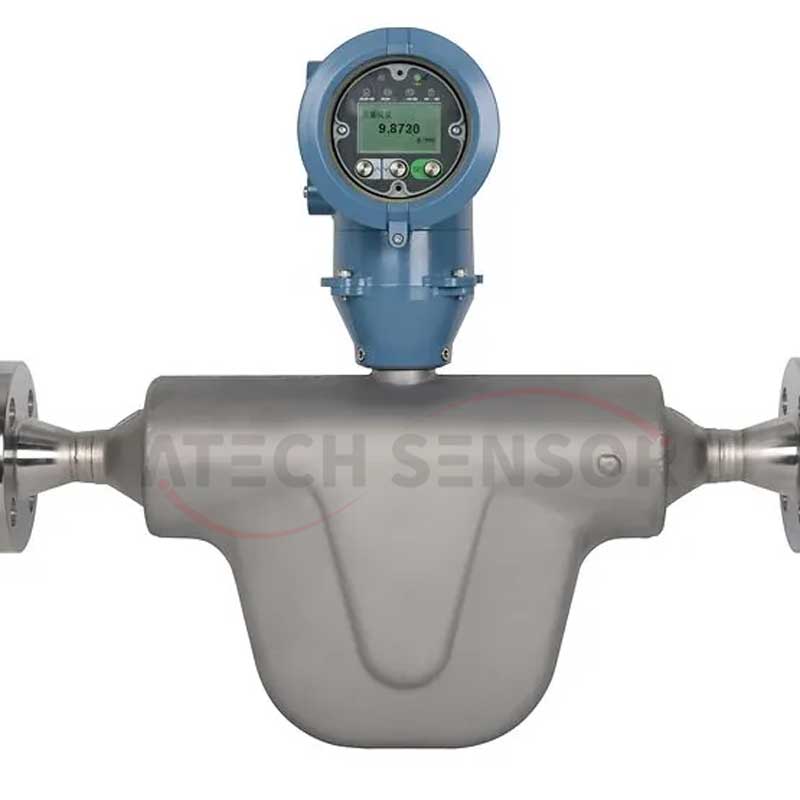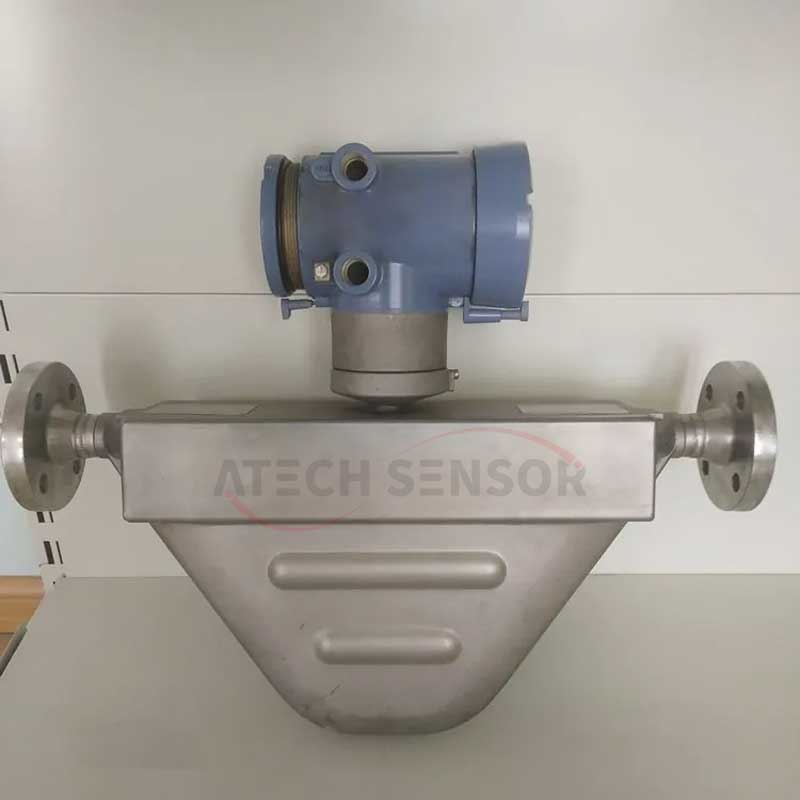Mass flow meter, flow instrument.
The volume of a fluid is a function of the temperature and pressure of the fluid and is a dependent variable, while the mass of a fluid is a quantity that does not change with time, space temperature, and pressure. As mentioned above, the flow measurement value of commonly used flow meters, such as orifice flowmeters, laminar mass flowmeters, turbine flowmeters, vortex flowmeters, electromagnetic flowmeters, rotor flowmeters, ultrasonic flowmeters, and elliptical gear flowmeters, is the volume flow rate of the fluid. The amount of fluid involved in scientific research, production process control, quality management, economic accounting, and trade transfer is generally mass. Using the above flowmeter to measure only the volume flow of the fluid often cannot meet people's requirements, and it is usually necessary to try to obtain the mass flow of the fluid. In the past, the mass of the fluid could only be obtained indirectly through correction, conversion, and compensation after measuring parameters such as the temperature, pressure, density, and volume of the fluid. This measurement method has many intermediate links, and the accuracy of mass flow measurement is difficult to guarantee and improve. With the development of modern science and technology, some metering methods and devices for directly measuring mass flow have emerged one after another, thus promoting the progress of flow measurement technology.

1. Brief Introduction
When the fluid flows in a rotating tube, it will generate a force on the tube wall. It was discovered by Coriolis in 1832 when he was studying turbines. It is referred to as Coriolis force. The mass flow meter is based on Coriolis force. There are two parallel flow tubes inside the sensor. The middle part is equipped with a drive coil and the two ends are equipped with detection coils. When the excitation voltage provided by the transmitter is added to the drive coil, the vibrating tube vibrates reciprocatingly. The fluid medium of the industrial process flows through the vibrating tube of the sensor, which will produce the Coriolis force effect on the vibrating tube, causing the two vibrating tubes to vibrate torsionally. The detection coils installed at both ends of the vibrating tube will generate two sets of signals with different phases. The phase difference of these two signals is proportional to the mass flow rate of the fluid flowing through the sensor. The computer calculates the mass flow rate flowing through the vibrating tube. When different media flow through the sensor, the main vibration frequency of the vibrating tube is different, and the density of the medium is calculated based on this. The platinum resistor installed on the sensor vibrating tube can indirectly measure the temperature of the medium.
The mass flow meter directly measures the mass flow of the medium passing through the flow meter, and can also measure the density of the medium and indirectly measure the temperature of the medium. Since the transmitter is an intelligent instrument with a single-chip microcomputer as the core, more than a dozen parameters can be derived for users to use based on the above three basic quantities. The mass flow meter is a new generation of flow meter with flexible configuration, powerful functions, and high performance-price ratio.
A flow meter that measures the mass flow rate in a pipeline. If only the volume flow rate is measured when the measured fluid is under conditions where parameters such as pressure and temperature change greatly, a large measurement error will be caused by the change in fluid density. In volumetric and differential pressure flow meters, the density of the measured fluid may change by 30%, which will cause a 30-40% error in the flow rate. With the improvement of automation levels, many production processes have put forward new requirements for flow measurement. The chemical reaction process is controlled by the quality (not volume) of the raw materials. The heating and cooling effects of steam and air flow are also proportional to the mass flow rate. Strict control of product quality, accurate cost accounting, and fuel quantity control of aircraft and missiles also require precision. Therefore, the mass flow meter is an important flow measurement instrument.
2. Measurement principle
The mass flow meter uses thermal measurement to measure the flow rate by measuring the molecular mass taken away by the split molecules. Because it uses thermal measurement, the measurement results will not be affected by changes in gas temperature and pressure. The mass flow meter is a relatively accurate, fast, reliable, efficient, stable and flexible flow measurement instrument. It will be more widely used in the fields of petroleum processing and chemical industry. It is believed that it will show great potential in promoting flow measurement. The mass flow meter cannot control the flow rate. It can only detect the mass flow rate of liquid or gas and output the flow value through analog voltage, current or serial communication. However, the mass flow controller is an instrument that can detect and control at the same time. In addition to the measurement part, the mass flow controller itself also has an electromagnetic regulating valve or piezoelectric valve, so that the mass flow control itself constitutes a closed-loop system for controlling the mass flow rate of the fluid. The set value of the mass flow controller can be provided by analog voltage, analog current, or computer or PLC.
3. Main features
● Applicable to a variety of media
● High measurement accuracy
● No straight pipe section required
● Good reliability
● Low maintenance rate
● With core processor
4. Main categories
Mass flow meters can be divided into two categories: one is direct type, which directly outputs mass flow; the other is indirect or derived type, such as the combination of ultrasonic flow meter and density meter, and then multiplying their outputs to obtain mass flow.
Direct type

There are many types of direct mass flowmeters, such as calorimetric, angular momentum, gyroscopic and double impeller types. This instrument is suitable for measuring small flow gases. The disadvantage is that it is highly inert, the measured value is related to the constant pressure specific heat of the gas, and the measuring element is in contact with the medium and is easily contaminated and corroded. It is a double-orifice differential pressure mass flowmeter. Two identical orifice plates are installed at pipes A and B. Two identical constant flow pumps that can produce a constant volume flow q in opposite directions are installed in the diversion pipe. The pressure difference before and after the two orifices △P=P1-P3=4KρQq is proportional to ρ and Q. In the formula, K is a constant coefficient, ρ is density, Q is the pipeline volume flow rate, and ρQ is the mass flow rate. The double-impeller mass flowmeter has two impellers with inclination angles x1 and x2 installed in front and behind on the same straight line. The two impellers are connected by a torsion spring. When the fluid passes through, an offset angle x is generated between the two impellers. Then the torque difference △M between the two impellers and the mass flow rate Qm, flow velocity u, inclination angles x1, x2 have the relationship △M=Qm*u*(k1*tgx1-k2*tgx2) (k1 and k2 are blade structure size constants), △M=k3*u*Qm, (k3=k1*tgx1-k2*tgx2). The offset angle x=k4*△M=k4*k3*Qm*u; and the impeller group rotation speed U is proportional to the flow velocity of the fluid, U=k6*u, then the time required for the entire impeller group to rotate through the two impeller deflection angles x △t=x/U=k7*Qm. The mass flow rate Qm can be obtained by measuring △t with a special counter.
Indirect type
There are 3 main types of indirect mass flowmeters: a combination of velocity flowmeter and density meter, a combination of throttling (or target) flowmeter and volumetric flowmeter, and a combination of throttling (or target) flowmeter and density meter.
There is also a type that converts the measured value of the volumetric flowmeter into the volumetric flow under standard conditions according to the working pressure and temperature of the fluid. However, when the type or composition of the medium changes, it cannot give an accurate mass flow rate. Strictly speaking, it does not belong to a mass flowmeter. Output density, specific gravity, volume flow, mass flow, mass energy flow, etc., and has multiple functions such as indication, analog output, printing, over-limit alarm, instrument failure alarm, etc.
Thermal type
The basic principle of thermal mass flowmeter is to use an external heat source to heat the measured fluid in the pipeline. The heat energy flows with the fluid, and the mass flow rate of the fluid is reflected by measuring the heat (temperature) change caused by the flow of the fluid.
When the fluid composition is determined, the constant pressure specific heat of the fluid is a known constant. Therefore, it can be seen from the above formula that if the heating power is kept constant, the mass flow rate can be calculated by measuring the temperature difference; if the constant temperature difference method is used, that is, the temperature difference between the two points is kept constant, the mass flow rate can also be calculated by measuring the heating power. Since the constant temperature difference method is relatively simple and easy to implement, it is widely used in practice. This flowmeter is mostly used for measuring larger gas flow rates.
In order to avoid the temperature measuring and heating elements being contaminated and corroded by the fluid due to direct contact with the measured fluid, a non-contact measurement method can be used, that is, the heater and the temperature measuring element are installed on the outside of the thin-walled tube, and the fluid passes through the inside of the thin-walled tube. The non-contact measurement method is suitable for measuring small flow rates in small-diameter pipelines. When used for large flow measurement, the diversion method can be used, that is, only measure the diverted part of the flow, and then obtain the total flow to expand the measuring range.
Differential pressure type
The differential pressure mass flowmeter is a flowmeter based on the Magnus effect. In practical applications, a combination of an orifice plate and a metering pump is used to achieve mass flow measurement. Common structures include a double orifice plate and a combination of a four-orifice plate and a metering pump.
The double orifice plate structure is to install two orifice plates A and B with exactly the same structure and size on the main pipeline, and install two metering pumps with opposite flow directions and fixed flow rates on the branch pipeline. The differential pressure gauge is connected to the inlet of orifice plate A and the outlet of orifice plate B.
Coriolis
The Coriolis mass flowmeter is an instrument that directly measures mass flow by using the principle that the fluid flows in a vibrating tube to generate a Coriolis force proportional to the mass flow.
There are many forms of Coriolis flowmeter structures, generally consisting of a vibrating tube and a converter. The vibrating tube (measuring pipe) is a sensitive device, which has several shapes such as U-shaped, Ω-shaped, annular, straight tube and spiral, and also has double tubes, but the basic principle is the same. The following is an example of a U-shaped tube mass flowmeter.
5. Technical indicators
Main parameters
Mass flow accuracy: ±0.002×flow±zero drift
Density measurement accuracy: ±0.003g/cm3
Density measurement range: 0.5~1.5g/cm3
Temperature measurement accuracy: ±1°C
Sensor
Ambient temperature: -40~60°C
Medium temperature: -50~200°C
Explosion-proof type: iBⅡBT3
Associated equipment: Matching transmitter
Transmitter
Working temperature: 0~60°C
Relative humidity: below 95%
Power supply: 220±10%VAC, 50Hz or 24±5%VDC, 40W
Calorific mass flowmeter. When the fluid is stationary, the temperature indicated by the thermocouples placed symmetrically at both ends of the heat source is equal. The commonly used bypass tube mass flowmeter divides the pipeline into countless small pipelines with a thin tube, then leads one of the pipelines out and places the sensor outside the bypass tube. This method separates the measuring element from the medium, but the response speed and accuracy are slightly lower. Through the advancement of processing technology, the accuracy and repeatability of the flowmeter have been greatly improved.
Double orifice plate differential pressure mass flowmeter. Two identical orifice plates are installed at pipes A and B. Two identical constant flow pumps that can produce constant volume flow q in opposite directions are installed in the diversion pipe. The pressure difference before and after the two orifice plates △P=P1-P3=4KρQq is proportional to ρ and Q. In the formula, K is a constant coefficient, ρ is density, Q is the pipe volume flow, and ρQ is the mass flow.
Double impeller mass flowmeter. Two impellers with different blade angles are coaxially installed in the housing, and connected together by a spring in the middle. The difference in torque between the two impellers causes the spring to twist at an angle α. α is proportional to the product of the mass flow M and the angular frequency &owega;, that is, α ∝M&owega;. The time required to measure the angular displacement α can be used to measure the M value. The measurement method is: install two electromagnetic detectors on the housing, and start counting when the first turbine generates a pulse. When the second turbine generates a pulse, stop counting. Measure the time t according to the standard frequency of the counter, and then calculate the M value.
There are three main types of indirect mass flow meters: a combination of a velocity flow meter and a density meter, a combination of a throttling (or target) flow meter and a volumetric flow meter, and a combination of a throttling (or target) flow meter and a density meter.
The mass flow meter with microcomputer is also called mass flow computer, which is a new type of universal flow meter. It can input the density, flow rate (turbine flowmeter, throttling flowmeter), specific gravity, temperature, pressure, heat and other signals of the fluid.
6. Troubleshooting
Hardware failure
If the error is too large, the totalizer display is not bright or does not increase, the display is blank, etc., the reasons are:
a. Improper installation can directly lead to zero drift of the flow meter, such as the mass flow meter is installed too close to the pump outlet, the sensor support strength is not enough, the connection flange welding is improper to generate stress signals, and the cable is subject to electromagnetic interference.
b. Wiring problem
If the display does not light up, check the power connection of the integrator. If the fuse is burned, confirm whether the input voltage is consistent with the standard voltage nominal value and the AC and DC forms. If the integrator does not increase with the flow rate, check the integrator wiring. If the integrator is equipped with a forward/reverse program, check the flow meter wiring. If the flow meter wiring is incorrect, the integrator will not increase in reverse flow.
c. Process medium changes
If the measured medium has air inclusion, gasification or two-phase flow, the transmitter will display an alarm. In severe cases, the sensor stops working.
d. Transmitter failure.
e. Sensor failure.
f. Pipeline purge problem.
Software problem
Mass flowmeter troubleshooting - For a flowmeter that has just been calibrated, you must pay attention to the zero point calibration under the current working conditions before installing and using it. You must ensure that the flowmeter is filled with medium and the stop valves at both ends are closed before zero point calibration. There are many specific methods.
a. Incorrect zero point calibration.
b. Incorrect parameter settings.
c. Pulse fluctuations in the power supply.
d. Incorrect i/o configuration (be sure to pay attention to the range).
e. Incorrect operation

